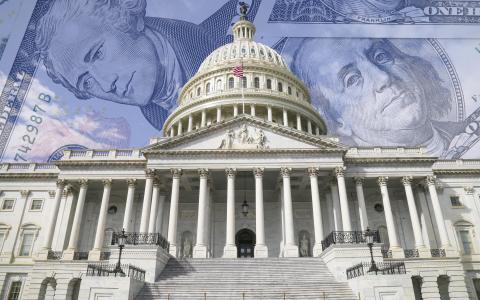
(Yahoo!Finance) - The most expensive government shutdown in history cost about $3 billion. That is what the Congressional Budget Office calculates was permanently taken out of the US economy during a 2019 standoff.
Now, with another shutdown looking increasingly likely to commence in just 13 days, the odds appear to be increasing daily that the price tag this time around could run even higher.
Between deeply entrenched sides — including House Republicans reportedly engaging in shouting matches behind closed doors and openly scoffing at the costs of a shutdown — as well as new risks posed by wary credit rating agencies, the coming shutdown could enter into uncharted fiscal territory, especially if a shutdown grows protracted.
The costs to the government and US economy grow with each passing day of shutdown and, while much of the held up money is belatedly spent when the government reopens, studies have documented that billions of dollars are likely to be lost permanently.
"This is a real thing that impacts people's lives and it doesn't seem to be a big factor in whether something gets done on time or not," notes Casey Burgat of the Graduate School of Political Management at The George Washington University.
"It's just something after the fact that we all point to and say, ‘Man, that was dumb.’"
How stoppages work
How long could the coming shutdown last? Goldman Sachs said in a recent note that its baseline expectation was two to three weeks, with Strategas Securities similarly looking at "about two weeks" as a strong possibility.
Those estimates — which plenty in Washington say are underplayed — would immediately rank among the longest shutdowns in history.
Others are pondering much longer and historically unprecedented timelines. Moody’s Analytics chief economist Mark Zandi has floated the idea of a shutdown that stretches throughout the entire fourth quarter, smashing the all-time record of 35 days and cutting 1.2 percentage points from fourth quarter growth.
Meanwhile, many conservative Republicans have sought to downplay the effects. Rep. Andy Biggs (R-Ariz.) characterized a shutdown as simply "a temporary pause in nonessential spending that would allow us to get our fiscal house in order." Adds Rep. Bob Good (R-VA): "We shouldn’t fear a government shutdown."
As they point out, much of the federal government continues normally in a shutdown. Programs such as Social Security and Medicare are unaffected.
But other programs that do rely on annual appropriations incur significant costs. These agencies must spend thousands of hours to develop contingency plans before a shutdown and then it is typical for furloughed workers to eventually be paid for their time.
Other federal workers — such as TSA agents in past shutdowns — are asked to report to work but don’t get paychecks until the government reopens.
It was just after the end of the longest shutdown in American history, which occurred from Dec. 22, 2018 until Jan. 25, 2019 and centered on a fight between then-President Trump and lawmakers over funding for a border wall, that the CBO analyzed the costs.
It estimated that the partial shutdown delayed $18 billion in federal spending and lowered the GDP in the first quarter of 2019 by $8 billion. Much of that shortfall was made up when the government reopened, but $3 billion was permanently lost due to furloughed federal workers, delays in federal spending, and a reduction in aggregate demand.
The report’s authors also note that "estimates do not incorporate other, more indirect negative effects of the shutdown, which are more difficult to quantify but were probably becoming more significant as it continued."
Those costs came in spite of a stoppage that was deemed a "partial" shutdown as Congress had enacted five of its 12 appropriations bills that year without drama.
This year, Congress hasn't found agreement on a single area of appropriations, increasing the likelihood of a full shutdown with wider costs this time around.
A new risk: Credit ratings
In addition to the direct economic costs, observers also see a new economic threat this time from the world of credit ratings.
In August, Fitch downgraded the US government's top credit rating and cited government dysfunction as a key reason for doing so. The move made it the second major agency to downgrade the US after the S&P did so back in 2011.
Moody’s is the last major agency to give the US Treasuries a clean AAA rating but Jeannette Lowe, Strategas Securities managing director of policy research, says that could be at risk.
"One thing that we're watching for with this current shutdown is would Moody's potentially put the US on a credit ratings watch during the shutdown because of it," she said in a recent Yahoo Finance appearance, adding that such a move would be a "significant event for financial markets in our view."
Even if a downgrade doesn’t happen, Fitch and others worried about US dysfunction “will get more ammunition for that argument” in the weeks ahead, notes Greg Valliere, chief US policy strategist at AGF Investments.
At the moment, an extended standoff seems increasingly likely based on newly bellicose statements made this week. Even Speaker McCarthy’s agreement with his right flank on Tuesday to launch an impeachment inquiry didn’t appear to lessen the shutdown pressure.
More and more expect it to be a lengthy affair. "This has all the ingredients of a protracted showdown," notes Gordon Gray of the American Action Forum.
He then added another sour note, pointing out how few shutdowns have ended with America in an improved fiscal position.
"It's costly [and] what do we get for that? Nothing" he says, adding wryly "the past episodes of shutdowns have not produced a reinvigorated republic."
By Ben Werschkul · Washington Correspondent
Ben Werschkul is Washington correspondent for Yahoo Finance.



